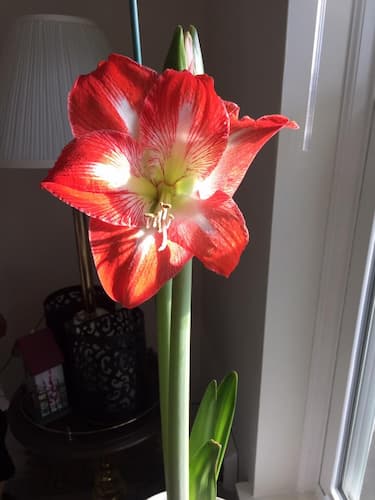How to Grow Amaryllis Flower Bulb Indoors of Out

About Growing Amaryllis Plants
Why do so many people enjoy growing Amaryllis Flowers indoors? First, Amaryllis plants are fast-growing and an easy to grow bulbs. Forcing Amaryllis bulbs to bloom indoors is a snap. Many garden stores carry them boxed, potted, and ready to grow by just adding water. Second, they have big, bright, trumpet-shaped blooms cheering up the indoor winter scene. For gardeners, winter can be long. Many avid gardeners just can’t wait until spring to partake in their favorite hobby. Many people need to grow something during the long winter. Growing indoor house plants help us to get through the long “off-season”. They make good container plants for your patio or deck, too.
The vast majority of Amaryllis bulbs are sold during the holiday season. They make great gifts for gardeners, as well as people who can’t easily get out and about during the winter months. But Amaryllis bulbs can also be planted in the flower bed in the spring.
The word Amaryllis comes from the Greek word for “sparkling”. They do just that, brightening up a spring lawn, or adding color indoors on a cold, drab winter’s day. Big, cheerful, trumpet-shaped blooms come in red, pink, yellow, and a few combinations of these colors. A single flower blooms six to eight weeks after planting. Plants can grow up to two feet.
Amaryllis are native to Central America, South America, and the West Cape region of Africa. They can be grown outdoors in frost-free areas. They also can be grown in colder regions. In cold regions, pull up the bulbs before winter, and store them until spring.
Other Names: Amaryllis is also called Naked Lady Flower. They got this name because there are no leaves when in bloom.
Amaryllis Plant Specifics
Flower Colors: Pink, red, white
Flower Blooms: Indoors in about 7 – 8 weeks.
Plant Type: Perennial Bulb
Plant Height: 1 – 2 feet tall.
Light Requirement: Full to partial shade
Ideal Soil pH: 5.5 – 6.5.
Hardiness Zone: 8 – 10
Toxicity: Toxic to humans and pets. It can cause vomiting and diarrhea.
Botanical Name: Liliaceae/Amaryllidaceae
Is Amaryllis Edible?
NO! The plant and especially the bulb is poisonous. Do not ingest it for any purpose. And keep the plant away from children and pets.
Medicinal Uses of Amaryllis Plant
As mentioned in the previous section, Amaryllis plants are harmful to humans and pets. It should not be ingested internally.
However, herbalists say there are some topical applications for the sap of the plant. Topical uses include:
Treatment of fungal diseases.
Treatment for athlete’s foot.
It also has anti-inflammatory properties.
Important Note: We strongly urge you to seek alternative treatment. There are many safer products on the market.
Amaryllis Flower Plant Propagation
Amaryllis plants are grown from a large bulb. If the plant is allowed to grow until the leaves turn yellow, the bulb will bloom for years. Like other bulbs, the plant needs time to grow and store energy in the bulb for next season. New plants are propagated by separating bulbs or from new seeds.
The flower also can produce seeds. You can promote new seed growth. When the flower blooms, gently hand pollinate the flower. After the plant dies off, you can harvest the seed head. Open the seeds and allow them to dry thoroughly before storing them.
Forcing Amaryllis Bulbs to Grow and Bloom Indoors
Amaryllis bulbs can easily be forced to bloom indoors any time of the year.
Plant Amaryllis bulbs with the upper third above ground in good, rich potting soil. The plant and bloom quickly grow big. Put just one bulb into a six-inch or larger pot. Use containers slightly bigger than the circumference of the bulb. They do not need a lot of soil and growing space indoors. The plant can grow up to two feet. To avoid tipping over, use a large, heavy flowerpot. It should also have holes in the bottom for good drainage.
The plants grow best in full sun. Plant them near a sunny window. Whether indoors or out, your Amaryllis will benefit from as much sunlight as you can provide it.
Planning on keeping your bulbs for next year? After forcing Amaryllis, continue to grow the plant after the bloom has died off. Apply a light dose of fertilizer once or twice, especially after blooming. Then, the bulb stores all the food it needs to bloom again. The fertilizer helps the plant store food for next year.
How to Grow Amaryllis Flowers Outdoors
With so much attention forcing amaryllis to bloom indoors, let’s not forget that they can be grown outdoors, too. The showy blooms look great in any flowerbed. Plant them singly, or in small groups.
Garden Tip: You can also plant Amaryllis bulbs in flowerpots on your patio or deck. They will look great!
Plant Amaryllis bulbs outdoors in the Spring. Grow them like any other flower bulb. Newly purchased bulbs contain the energy needed to grow and bloom the first year. However, they need fertilizer and rich soil to grow and ultimately store energy in the bulb for next year’s bloom.
More on How to Plant and Grow Bulbs
The flower stalk and flower will emerge first, followed by leaves. Do not cut the plant back until the leaves have yellowed and died. If grown outdoors, provide a layer of mulch to protect them from frost.
Ideal Soil pH: 6.0 – 8.0.
Also, See:
Plant Problems – causes and cures
Related Articles
Please support our site. Shop for:
- rmmatthews100@hotmail.com
- 585-721-6528
- Rochester, NY
©1999-2024 GardenersNet.Com, All Rights Reserved

